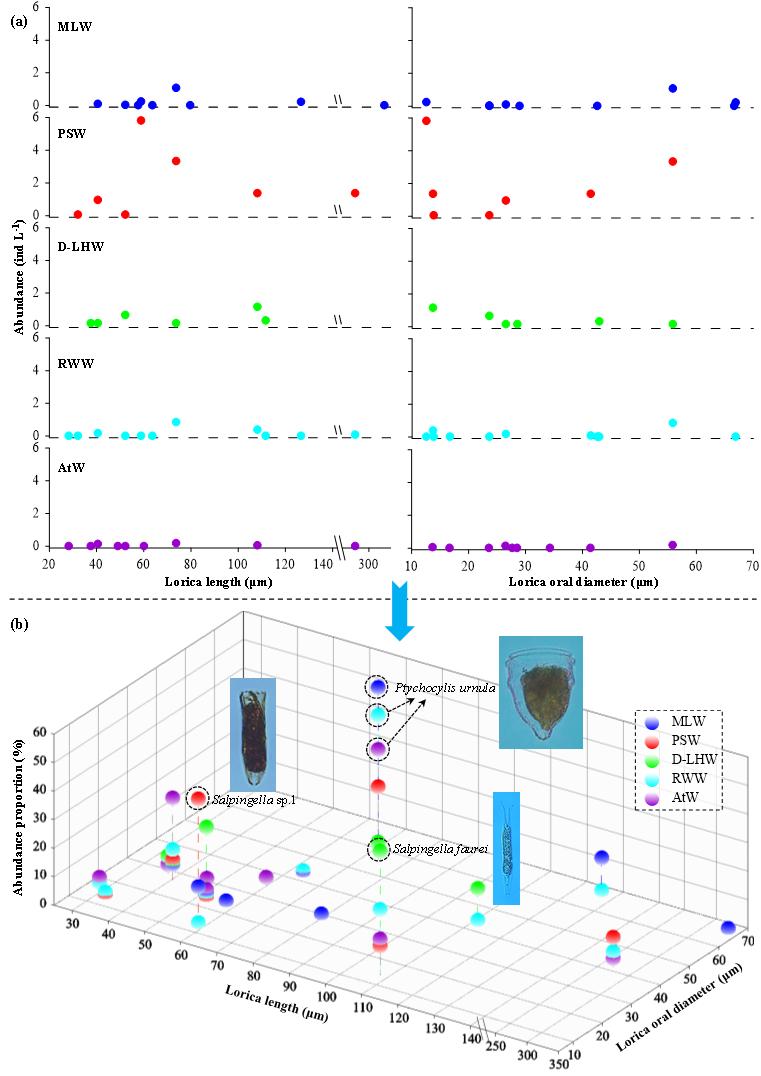Novel Bio-index Helps Indicate Future Arctic Climate Change through Microzooplankton
Planktonic ciliates (belonging to microzooplankton) are single-celled protozoa in the marine ecosystem, which are considered as bioindicators of various oceanographic conditions. The Arctic Ocean is experiencing rapid changes due to Global Warming, and it contains complex water masses with unique hydrographic features and zooplankton communities.
Recently, Dr. WANG Chaofeng of Prof. ZHANG Wuchang's team from the Institute of Oceanology of the Chinese Academy of Sciences (IOCAS) and his collaborators investigated the full-depth vertical distribution of planktonic ciliates and created a novel bio-index for indicating habitat suitability of tintinnid in the Arctic Ocean.
The study was published in Marine Environmental Research on Feb. 18.
Researchers found that planktonic ciliate community structure showed obvious variations in different water masses, and classified habitat suitability of tintinnid abundant species through a novel bio-index. In addition, Pacific-origin tintinnid invaded in the Canada Basin, revealing a rapid borealization progress of Arctic microzooplankton.
They also found that five water masses occurred in the Arctic Basin, and each of them had unique tintinnid community structure. Aloricate ciliates paly a key role in pelagic marine ecosystem compared to tintinnids with average abundance proportion to total ciliates > 95%. Additionally, its large (>30 μm) and small (10–20 μm) size-fractions were dominant in shallow and deep waters, respectively.
Tintinnids act as bioindicator for indicating different water masses of the Arctic Ocean. Combined with the dominant Pacific-origin species Salpingella sp.1 in the Pacific Summer Water, and three new record tintinnid species found during this survey, they speculated that the borealization progress become more rapid in the Arctic Ocean.
"The habitat suitability of tintinnid abundant species was characterised by the Bio-index, which revealed a distinct death-zone for each species," said Dr. WANG. Compared with previous studies, the increase of Pacific Summer Water thickness and average temperature might be the reason for more ciliates with small body size invading into the Arctic Ocean.
"Additionally, through comparing variations in survival habitat of abundant tintinnids, we can monitor and indicate the future Arctic climate change," added Dr. WANG.
The study was supported by National Natural Science Foundation of China, Shandong Provincial Natural Science Foundation, China Postdoctoral Science Foundation, and the Applied Research Project for Postdoctoral in Qingdao.

Fig. 1 Survey stations in the Arctic Ocean and the novel Bio-index for tintinnid survival habitat classification through abundance proportion of empty lorica to total tintinnid abundance.

Fig. 2 Three-dimensional representation for abundance and abundance proportion of tintinnid lorica length and lorica oral diameter in different water masses of the Arctic Ocean. MLW, Mixed Layer Water; PSW, Pacific Summer Water; D-LHW, Diapycnally mixed Lower Halocline Water; RWW, Remnant Winter Water, including Eurasian Winter Water and Pacific Winter Water; AtW, Atlantic-origin Water.
Chaofeng Wang, Xiaoyu Wang, Zhiqiang Xu, Guangfu Luo, Chao Chen, Haibo Li, Yunpeng Liu, Jingyuan Li, Jianfeng He, Hongxia Chen, Wuchang Zhang. (2023). Full-depth vertical distribution of planktonic ciliates (Ciliophora) and a novel bio-index for indicating habitat suitability of tintinnid in the Arctic Ocean. Marine Environmental Research.
(Text by WANG Chaofeng)
Media Contact:
ZHANG Yiyi
Institute of Oceanology
E-mail: zhangyiyi@qdio.ac.cn
(Editor: ZHANG Yiyi)